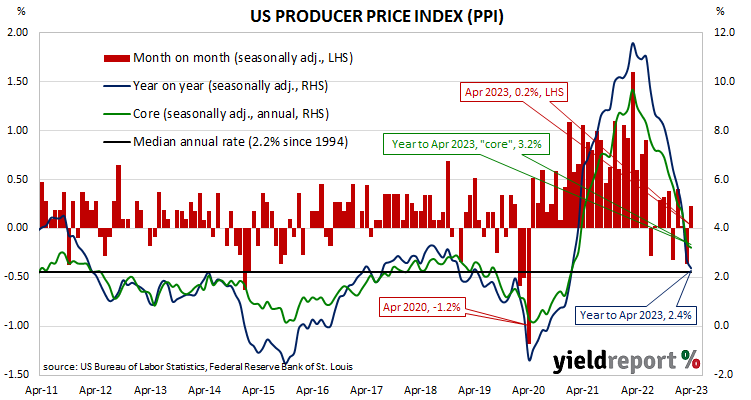Summary: US producer price index (PPI) up 0.2% in April, less than expected; annual rate slows to 2.4%; “core” PPI also up 0.2%; ANZ: ongoing price pressures in core services; Treasury yields down; rate-fall expectations soften; goods prices up 0.2%, services prices up 0.3%.
Around the end of 2018, the annual inflation rate of the US producer price index (PPI) began a downtrend which continued through 2019. Months in which producer prices increased suggested the trend may have been coming to an end, only for it to continue, culminating in a plunge in April 2020. Figures returned to “normal” towards the end of that year but annual rates through 2021 and 2022 were well above the long-term average.
The latest figures published by the Bureau of Labor Statistics indicate producer prices increased by 0.2% after seasonal adjustments in April. The rise was less than the 0.3% increase which had been generally expected but in contrast with March’s 0.4% fall after it was revised up from -0.5%. On a 12-month basis, the rate of producer price inflation after seasonal adjustments and revisions slowed from 2.8% in March to 2.4%.
Producer prices excluding foods and energy, or “core” PPI, also increase by 0.2% after seasonal adjustments. The result was in line with the expectations but above March’s flat result and the annual rate slowed from March’s figure of 3.4% to 3.2%.
“Petrol prices in the US lifted more slowly than expected, while food prices actually fell,” said ANZ Head of FX Research Mahjabeen Zaman. However, she also noted “ongoing price pressures in core services.”
US Treasury bond yields fell on the day. By the close of business, the 2-year Treasury yield had slipped 1bp to 3.90%, the 10-year yield had lost 6bps to 3.38% while the 30-year yield finished 7bps lower at 3.73%.
In terms of US Fed policy, expectations of a lower federal funds rate through the remainder of 2023 and into 2024 softened slightly. At the close of business, contracts implied the effective federal funds rate would average 5.075% in June, essentially unchanged from the current spot rate, and then slip a touch to an average of 5.065% in July. September futures contracts implied a 4.915% average effective federal funds rate while May 2024 contracts implied 3.54%, 154bps less than the current rate.
The BLS stated higher prices for final demand goods rose by 0.2% on average. Prices of final demand services increased by 0.3%.
The producer price index is a measure of prices received by producers for domestically produced goods, services and construction. It is put together in a fashion similar to the consumer price index (CPI) except it measures prices received from the producer’s perspective rather than from the perspective of a retailer or a consumer. It is another one of the various measures of inflation tracked by the US Fed, along with core personal consumption expenditure (PCE) price data.


